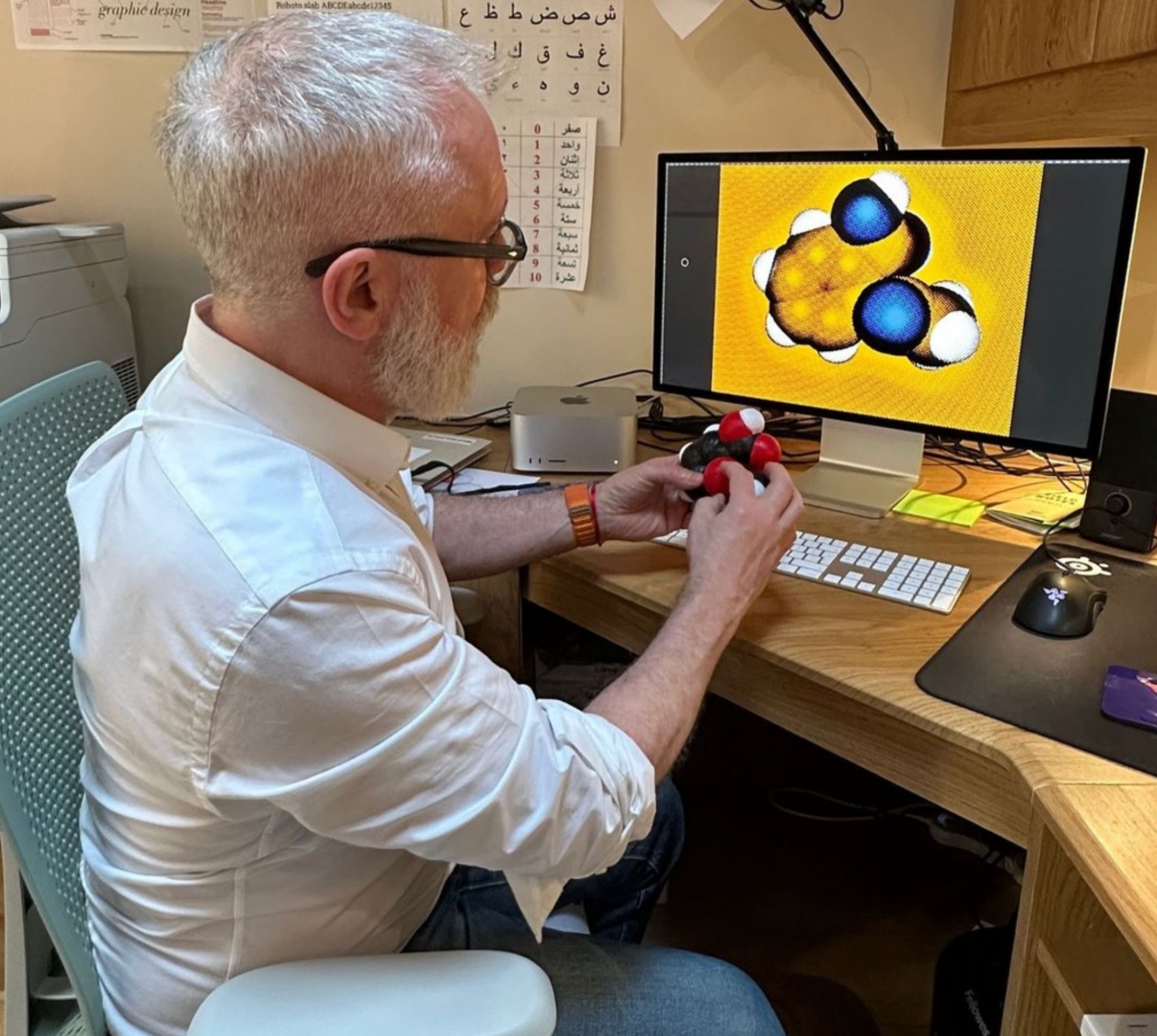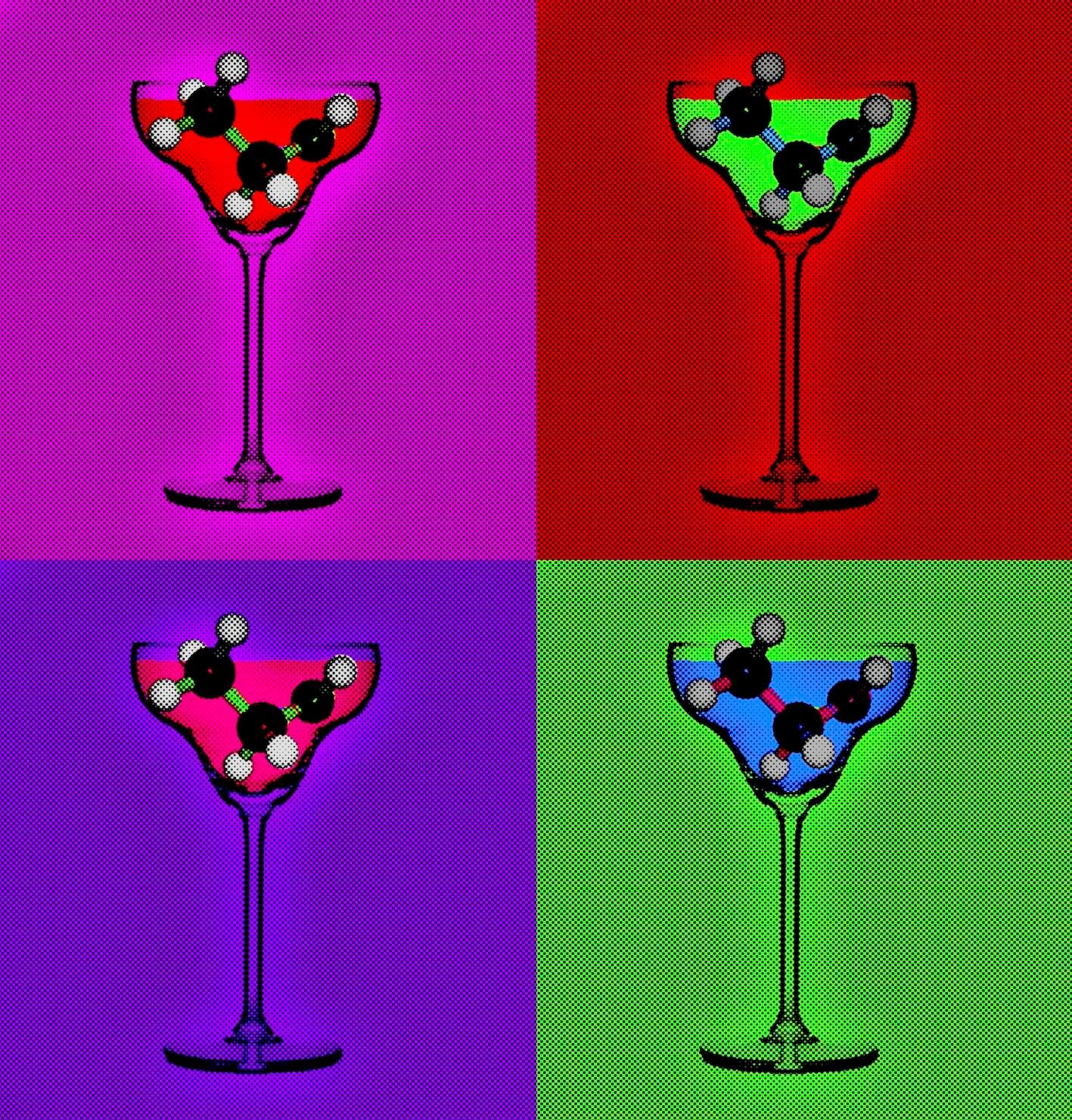Dr Drew Provan is a practising physician in haematology and an author-illustrator of textbooks for medical students and clinicians and other titles. Recently he has started turning science into art, reimagining molecules in sassy colours that leap from paper and metal for modern homes.
“I have always been obsessed with biochemistry and molecular biology,” says Drew, “and fascinated by the weird and wonderful shapes of molecules generally. They’re so logical with the components following the rules of chemistry and yet the molecules made up when the atoms of various elements are added together, range from simple and symmetrical to highly complex shapes. Some are very simple and yet vital to our systems, like water (H2O), whilst others are much larger, relatively. Some repeat with striking structures like the beautiful double helix of DNA whilst others are odd irregular shapes.
 Although I was drawn to the science of molecules and became a haematologist, I always had a creative side. Other than designing and illustrating my books, it largely lay dormant for thirty years because, being a doctor, I had no spare time. During the pandemic, however, I began developing my illustrations into art. I had been drawing the molecule I was working with – a drug I developed as Medical Director of Glaxo - to treat a disorder called ITP (immune thrombocytopena) which is caused by an immune attack against an individual’s own platelets. It was a really pleasing shape and I wondered what it would look like it in a big bold pop-art style. I played around with it to make it chunky in cheerful colours with a Roy Lichenstein twist. It looked pretty cool!
Although I was drawn to the science of molecules and became a haematologist, I always had a creative side. Other than designing and illustrating my books, it largely lay dormant for thirty years because, being a doctor, I had no spare time. During the pandemic, however, I began developing my illustrations into art. I had been drawing the molecule I was working with – a drug I developed as Medical Director of Glaxo - to treat a disorder called ITP (immune thrombocytopena) which is caused by an immune attack against an individual’s own platelets. It was a really pleasing shape and I wondered what it would look like it in a big bold pop-art style. I played around with it to make it chunky in cheerful colours with a Roy Lichenstein twist. It looked pretty cool!
I am a pop art collector – Warhol is a hero of mine – and I am also inspired by Damien Hirst’s spot series and the strength and colour of David Hockney’s work, too. I have also always been intrigued by the potential of the digital world and digital art and so my art combines these influences. By making molecules bright and engaging, I hope that scientists will look at them afresh but more importantly, that they will draw in people from all walks of life and make science accessible to everyone. You might think it is an unusual idea to have a molecule on your wall, but pop-art came about to celebrate popular and common objects. Before Andy Warhol painted them, it would have seemed a bonkers to hang a picture of a can of soup on your wall, and tiny molecules like these are so much more impressive than cans of soup. With their various textures and patterns and their crazy or elegant structures, molecules like these underpin everyday existence: they’re what make us what we are. I went on to design ascorbic acid/vitamin C, testosterone and the feel-good hormone adrenaline, for example.”
And are the molecules coloured in real life? I ask.
“It’s hard to know for certain,” explains Drew. “Some certainly are if you have them in a great enough concentration; for example iron oxide is rust red or copper sulphate is a startling blue but single molecules and the constituent atoms are far too tiny to be visible.”
 For this reason, scientists generally stick with a convention which dates back to 1952 and two chemists, Robert Corey and Linus Pauling who assigned colours to elements. In scientific diagrams, therefore, carbon atoms are generally depicted as black, oxygen as red, hydrogen as white and nitrogen as yellow. “Built up as stick and ball structures, this system is clear and simple for students to use,” says Drew, “but the molecules look very plain and practical and yet they do such incredible things in the body. I have taken them out of their textbook ‘clothing’ and make them trendy and intriguing. By adding character with lurid colours and unexpected colour combinations and showing different molecules in an almost space-age playful way, I hope to make them a conversation piece.”
For this reason, scientists generally stick with a convention which dates back to 1952 and two chemists, Robert Corey and Linus Pauling who assigned colours to elements. In scientific diagrams, therefore, carbon atoms are generally depicted as black, oxygen as red, hydrogen as white and nitrogen as yellow. “Built up as stick and ball structures, this system is clear and simple for students to use,” says Drew, “but the molecules look very plain and practical and yet they do such incredible things in the body. I have taken them out of their textbook ‘clothing’ and make them trendy and intriguing. By adding character with lurid colours and unexpected colour combinations and showing different molecules in an almost space-age playful way, I hope to make them a conversation piece.”
Inspired by aspirin (“I loved its simplicity), Drew went on to develop a ‘pain’ series in which he included paracetamol and ibuprofen, amongst other forms of relief, and a ‘pleasure’ series, which ranges from caffeine, nicotine and Viagra to forbidden narcotics like cocaine and heroin. “Whereas some of my art celebrates health and well-being, other pieces have a darker edge. The subversive can therefore invite their puritanical granny for afternoon tea underneath a bulbous LSD molecule which would certainly liven up the room. I have added glitter to some of the artworks and with the hallucinogenic PCP (phenylcyclohexyl piperidine) commonly known as Angel dust I included wings that sparkle with a diamond glitz,” Drew smiles.
Ethanol which is popularly called alcohol he presents in a cocktail glass. “It’s fascinating that a tiny simple molecule like alcohol can have such an effect on the body, on lives and populations too. All of these molecules have a biochemical and a social story to tell,” he continues. “I have also, for example, given adenochrome the pop-art treatment because it’s an intriguing if terrifying prospect: it’s a chemical which conspiracy theorists have recently suggested can be harvested from terrified children for a futuristic treatment to make celebrities stay looking young.”
“I have also designed a couple of pieces simply because the name of the molecule made me smile,” continues Drew. “There’s Moronic Acid which found in plants like white mulberry and Arsole, an organoarsenic compound that contains an arsenic atom and a five-membered ring consisting of four carbon atoms and one arsenic atom. I guess the name was chosen because it contains an arsenic atom but it may have been wiser to name it something else…”
Drew’s collection also includes several viruses and his own karyotype (or complete set of chromosomes) from an old black and white picture that dates back from the mid 1980s. “They looked so dull in black and white and yet they contain all the coding to make me,” says Drew. “I’d like to think I am more interesting than that old monochrome image and so I gave it a pop-art upgrade too”.









